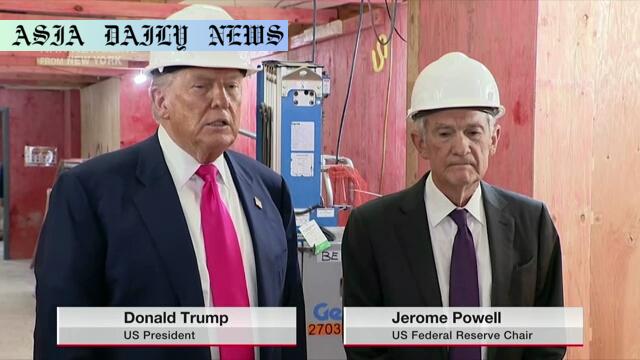Federal Reserve: President Trump criticizes Jerome Powell and discusses $3.1 billion in renovation costs during an inspection tour.
Federal Reserve renovations under scrutiny by President Trump.
Trump and Powell exchange critiques on renovation costs and policies.
Inspection occurs ahead of the Fed’s upcoming policy meeting.

Trump’s Visit to the Federal Reserve Headquarters
President Donald Trump recently made waves by visiting the headquarters of the Federal Reserve in Washington, an institution historically operating independently from the political spectacle. This marked the first visit by a sitting president since 2006. The visit, characterized by tension between Trump and Federal Reserve Chair Jerome Powell, highlighted ongoing criticism of the institution’s economic policies and renovation costs leading to substantial media coverage.
The inspection tour centered around the Federal Reserve’s headquarters renovation project, involving two historic buildings undergoing modernization since 2022. This initiative, aimed at upgrading the infrastructure, has drawn sharp scrutiny from the White House and Trump personally. He accused Powell of poorly managing the expenses, claiming the budget had ballooned to $3.1 billion. Powell, however, corrected this assertion, explaining that Trump had mistakenly included costs from a different building completed five years prior.
Trump’s persistent criticisms of Powell tabled not only the renovation issue but also broader frustrations. Trump reiterated his belief that the Federal Reserve should lower interest rates more aggressively, pointing to what he perceives as an overly cautious approach to stimulating the economy. While Powell defended the Federal Reserve’s discretionary policies, this public exchange underlined the growing rift and challenges the Federal Reserve faces in maintaining its apolitical stance.
An Investigation into Renovation Costs
The renovation’s budget has become a focal point, with the White House referring to the project as the “Taj Mahal on the National Mall.” This nickname underscores the administration’s portrayal of the project as excessive and extravagant. The ongoing renovations have stirred debates over fiscal responsibility, especially during a time of rising public concern over federal spending.
During the tour, Trump openly questioned the project’s necessity and alleged mismanagement incensed by the perceived cost spiral. However, the Federal Reserve has maintained that the renovations are vital to its operational efficiency and preservation efforts for the historic buildings. With funds allocated over a long-term budget, Powell expressed hope that the public would eventually recognize the project’s significance.
Political Ramifications of Trump’s Criticism
Beyond the renovation controversy, Trump’s visit and critique of Powell highlight a deeper political stratagem. His repeated calls for interest rate reductions, paired with public dissatisfaction with Powell’s leadership, aim to influence public perception of the Federal Reserve’s independence. Trump has long argued for a more aggressive monetary policy to drive economic growth, though such efforts have met resistance from economists concerned with inflationary risks.
This latest confrontation could spark further debates regarding the President’s involvement in economic policy, the Federal Reserve’s role, and the line separating politics from economic oversight. As the Federal Reserve prepares for its upcoming policy meeting, these tensions will likely continue to echo, positioning Trump’s criticisms as a critical component of ongoing dialogue surrounding fiscal management in the United States.
All in all, Trump’s visit to the Federal Reserve sheds light on the intersection of politics, finance, and public accountability. Whether this bold move will achieve its intended political leverage or merely spark short-term media resonance remains to be seen.
Commentary
Trump’s Provocative Visit and Its Implications
President Trump’s visit to the Federal Reserve headquarters was undoubtedly a bold move, marking a significant moment in the ongoing tug-of-war between political influence and institutional independence. The accompanying criticism of Jerome Powell, coupled with disputes over renovation costs, was deliberate in drawing attention to issues of federal spending and monetary policy. From an analytical perspective, this signals Trump’s strategic approach to consolidating voter sentiment, especially as economic debates continue to dominate political discourse in the United States.
The Economic Narrative at Play
By painting the Federal Reserve’s renovation project as emblematic of larger governmental fiscal excess, Trump used the event to highlight broader concerns surrounding financial management in Washington. This move resonates with a public increasingly wary of government overspending. However, Jerome Powell’s clarification regarding renovation costs illustrates the complexities of long-term federal planning and raises a necessary discussion on methodology versus perception. While it is easy to politicize such matters, Powell’s defense suggests that deeper examination of the Federal Reserve’s budgeting strategies could foster greater public understanding.
Reframing the Federal Reserve’s Independence
The most profound takeaway from this visit is the potentially precarious position of the Federal Reserve amidst rising political scrutiny. A long-cherished attribute of the Federal Reserve has been its independence, an assurance to markets that decisions are made free of political encumbrance. Trump’s repeated public criticism, particularly in front of media during the inspection tour, adds layers of complexity to this independence narrative. Striking balance between autonomy and accountability remains crucial as the United States navigates its economic challenges.
In conclusion, Trump’s visit and critique highlight important national debates on fiscal responsibility, monetary policy, and the boundaries of political influence. As this narrative continues to unfurl, its implications for the Federal Reserve and public trust in key institutions will be critical points for ongoing reflection and discourse.


